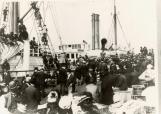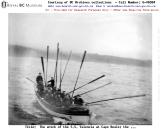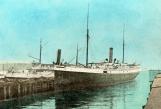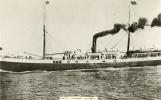1
When the SS Valencia sank off the coast of Vancouver Island on Monday, January 22nd, 1906, not only did an immense tragedy unfold, it did so over the course of several days. The effect of the sinking was profound.The last paragraph of THE WRECK OF THE VALENCIA
The First Complete Account Published of the Recent Disaster Off the West Coast of Vancouver Island by Clarence H. Baily (from the Pacific Monthly, Vol. X11, March 1906, No. 3, The Pacific Monthly Publishing Company, Portland, Oregon Pgs 281-292.reference contained pg. 292) reported that:
"If the casting away of the Valencia on the "deadly West Coast" of Vancouver Island, a stretch of rocks that has, during the past thirty-nine years, been responsible for the loss of sixteen vessels and the throwing away of seven hundred and sixty-three lives, will result in some governmental action being taken that will safe-guard the people of two countries traveling on the seas, then the wrecking of the ‘Valencia, horrible though it was, will not be an entirely useless thing."
In the wake of the tragedy, changes were made to navigation on the west coast of Vancouver Island that were intended to prevent such a disaster from occurring again. The telegraph trail that was instrumental in rescue efforts was improved, Pachena Lighthouse was built and a lifeboat station was established at Clo-oose, a boathouse and boat slip were built at Ucluelet lifeboat station and a house, boat slip and kitchen annex were built at the Bamfield Creek lifeboat station.
These were the immediate changes that occurred. And now, as we put this exhibit together, the Queen of the North, one of BC Ferries fleet of passenger ferries, has sunk off the north coast of Vancouver Island. Two lives are believed to have been lost. Although we have come a long way since the victims of the Valencia perished in such a lonely and terrifying fashion, one hundred years ago, it is a reminder to us all that ship wrecks and tragedy are still a threat, despite modern navigational aids.
The sinking of the Valencia was a catalyst for change on the west coast of Vancouver Island, and our story is of how our community, both Bamfield and our geographic area, have evolved and grown in its wake.
3
Brief History of the Valencia:She was built 1882 in Philadelphia by William Cramp and Sons for Pacific Steam Whaling Company of San Francisco. (1)
She served on the East Coast until 1898 when she became part of the gold rush fleet - moving people and freight between Skagway and San Francisco for the Pacific Packing and Navigation Company. (2)
1899 -On the San Francisco to Cook Inlet and Copper River run via Puget Sound. (1)
1899 -Requisitioned as a US Army transport for service to the Philippines.
1900 -Back on Alaska run for Pacific Whaling Company. (1)
1902 -Bought for $137,500 by Pacific Coast Steamship Company. (1)
The Valencia was wrecked on the shore of Vancouver Island, January 22, 1906
Physical Description:
iron-hulled (2)
-1598 gross tones (2)
-252 ft. long (2,3)
-34 ft. beam, draft 19 ft. without load (3)
-100 ft. bow gave appearance of speed (2)
-Not designed to plow the open waters of the North Pacific in winter. (2)
-Carried 6 lifeboats. another craft, #7, was working boat that doubled as a lifeboat. Total occupants 181 (2)
-2 of the lifeboats were wooden, rest metal of a self-righting design. (2)
-Carried 3 life rafts. Total occupants- 44 people. (2)
-386 life preservers, 315 of which used tule, (similar to cattail fibres), for bouyancy, a material that more easily than most became waterlogged. (2,3)
(1) Source of information -from the files of Donald Graham, Author of Keepers of the Light, courtesy Vancouver Maritime Museum
(2) Source of information Great Shipwrecks of the Pacific Coast Robert C. Belyk
(3) Wreck of the Steamer Valencia, Report to the President of the Federal Commission of Investigation.
5
Drawing of the S.S. Valencia courtesy of Jack Case.7
Drawing of the S.S. Valencia courtesy of Jack Case.9
Photo courtesy of The Vancouver Maritime MuseumThe photo is described as being a Valencia Postcard, and is supposedly of the SS Valencia.
Date: Undetermined
The Valencia had had a troubled past.
• In 1901 her purser was arrested for overselling tickets for personal gain and fined almost $9000. (2)
• On February 24, 1903 she was rammed by a small wooden craft, the GEORGIA. No damage was sustained to the GEORGIA, but VALENCIA had six or seven iron plates damaged, one being pierced, two fallen aft stringers and two frames broken showing structural weaknesses. (1)
• In 1905, under Captain Johnson, on the return journey from Nome Alaska to San Francisco, the VALENCIA is run hard aground, forcing the crew to jettison cargo to refloat her. (1)
• Shortly before her ill-fated journey, the vessel CITY OF PEUBLA breaks her tail shaft, forcing the Valencia into service. (2)
• Captain Johnson has less than 2 years experience as master, having been quartermaster for the Pacific Coast Steamship company for a number of years. (2)
• Captain Johnson was not experienced with travel on the coast in the winter months. (2)
• The crew was unfamiliar with the ship. No fire drills were conducted before departing port in San Francisco. (2)
(1) Source of Information: Donald Graham, courtesy Vancouver Maritime Museum
(2) Source of Information: Great Shipwrecks of the Pacific Coast, Robert C. Belyk
10
The Valencia loading passengers1906
Meiggs Wharf, San Francisco, California, United States of America

11
The Journey from San Francisco January 20th, 1906.The SS Valencia departs Meiggs Wharf, San Francisco headed to Victoria and Seattle with 164 passengers and crew. The Valencia encounters fog soon into her journey.
"At this point, according to the subsequent board of inquiry, Captain Johnson should have taken frequent soundings and compared them with those on his chart in order to establish his position. Instead, he proceeded by means of dead reckoning - an unscientific combination of occasional soundings, experience and instinct. Had he taken frequent soundings, a definite line of readings varying from 25 to 50 fathoms would have been obtained along the coastline, and anything above or below this range would have indicated that he was off course. Furthermore, at the entrance to the Juan de Fuca Strait, the bottom suddenly drops off to a much greater depth, giving soundings ranging from 120 to 180 fathoms. When over this 'hole,' said the board of inquiry, a mariner could be in only one place-off the entrance to the Strait, and could then turn and proceed up the Strait." (3)
At 6 pm on January 22, Captain Johnson orders sounding to be taken with the lead line, knowing that the deep waters off Cape Flattery will alert of them of the need to turn into the Straits of Juan de Fuca. (2,4)
At 9 p.m., Johnson orders the course changed assuming that the Umatilla lightship, 14 miles south of Cape Flattery is at hand. (4)
"Sixty fathoms still lay under Valencia's belly at 10:30. Perplexed, her captain rang the telegraph for HALF SPEED, then around to DEAD SLOW…..10:45. "eighty fathoms"; 11:00 p.m. "sixty" - much too shallow for the mouth of the Straits, where a sounding would disclose a depth of 150 fathoms or more." (4)
By 11:30 they are in 33 fathoms, then 24. Shortly after, the ship hits a rock outcropping. The captain exclaimed in shock. "In the name of God, where are we!" (4)
The FULL ASTERN order is given, and the Valencia is freed from the rocks, but below, the ship is rapidly filling with sea water. "I will not sink in deep water," (4) Captain Johnson declares, and gives the order for FULL SPEAD AHEAD, hoping to run her up on shore.
Sources:
(2) Great Shipwrecks of the Pacific Coast, Robert C. Belyk
(3) "Breakers Ahead!" On The Graveyard of the Pacific Bruce Scott
(4) Keepers of the Light Donald Graham
13
Line gun - used to shoot a line to shore from smaller vessels.The Valencia used a cannon - like cun called a Lyle gun.
Line gun donated for display on the 100th anniversity of the Sinking of the Valencia at a commemorative display.
14
The wreck of the S.S. Valencia at Cape Beale23 January 1906
West Coast of Vancouver Island, British Columbia, Canada





